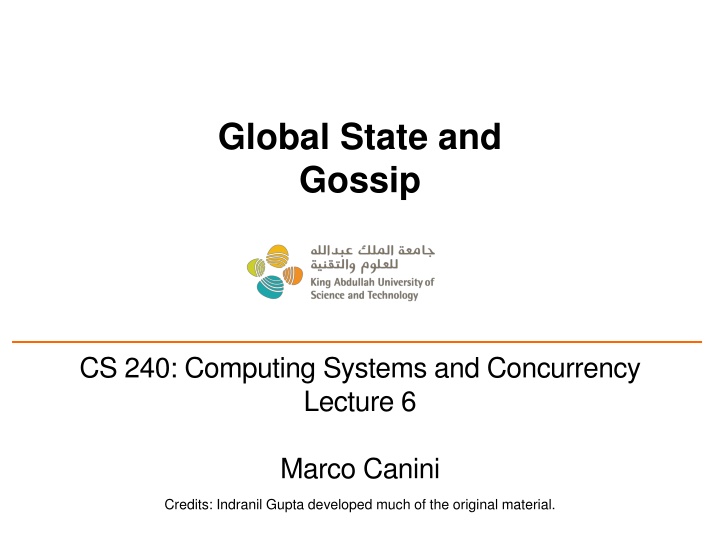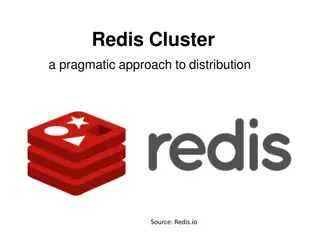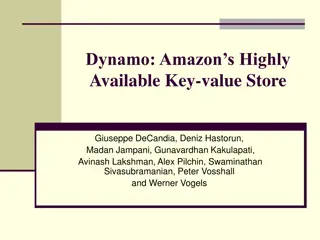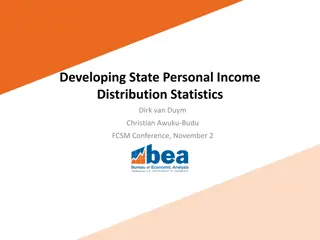Global State and Gossip
Learn about calculating global snapshots, Chandy-Lamport's algorithm, uses of system snapshots, and more in distributed systems. Understand the importance of global snapshots and their applications.
Uploaded on Feb 17, 2025 | 0 Views
Download Presentation

Please find below an Image/Link to download the presentation.
The content on the website is provided AS IS for your information and personal use only. It may not be sold, licensed, or shared on other websites without obtaining consent from the author.If you encounter any issues during the download, it is possible that the publisher has removed the file from their server.
You are allowed to download the files provided on this website for personal or commercial use, subject to the condition that they are used lawfully. All files are the property of their respective owners.
The content on the website is provided AS IS for your information and personal use only. It may not be sold, licensed, or shared on other websites without obtaining consent from the author.
E N D
Presentation Transcript
Global State and Gossip CS 240: Computing Systems and Concurrency Lecture 6 Marco Canini Credits: Indranil Gupta developed much of the original material.
Today 1. Global snapshot of a distributed system 2. Chandy-Lamport s algorithm 3. Gossip 2
Distributed snapshot Let s think of this as a picture of all servers and their states comprising a distributed system How do you calculate a global snapshot in a distributed system? What does a global snapshot even mean? Why is the ability to obtain a global snapshot important? 3
Some uses of global system snapshot Checkpointing can restart distributed system on failure Gargabe collection of objects objects at servers that don t have any other objects (at any servers) with references to them Deadlock detection useful in database transaction systems Termination of computation useful in batch computing systems Debugging useful to inspect the global state of the system 4
Whats a global snapshot? Global Snapshot = Global State = Individual state of each process in the distributed system + Individual state of each communication channel in the distributed system Capture the instantaneous state of each process And the instantaneous state of each communication channel, i.e., messages in transit on the channels 5
A strawman solution Synchronize clocks of all processes Ask all processes to record their states at known time t Problems? Time synchronization always has error Your bank might inform you, We lost the state of our distributed cluster due to a 1 ms clock skew in our snapshot algorithm. Also, does not record the state of messages in the channels Again: synchronization not required causality is enough! 6
Example Pi Cij Cji Pj 7
[$1000, 100 iPhones] Pi Cij [empty] [empty] Cji Pj [$600, 50 Androids] [Global Snapshot 0] 8
[$701, Pi 100 iPhones] Cij [empty] [$299, Order Android ] Cji Pj [$600, 50 Androids] [Global Snapshot 1] 9
[$701, Pi 100 iPhones] Cij [$499, Order iPhone] [$299, Order Android ] Cji Pj [$101, 50 Androids] [Global Snapshot 2] 10
[$1200, 1 iPhone order from Pj, 100 iPhones] Pi Cij [empty] [$299, Order Android ] Cji Pj [$101, 50 Androids] [Global Snapshot 3] 11
[$1200, 99 iPhones] Pi Cij [empty] [ ($299, Order Android), (1 iPhone) ] Cji Pj [$101, 50 Androids] [Global Snapshot 4] 12
[$1200, 99 iPhones] Pi Cij [empty] [ (1 iPhone) ] Cji [$400, 1 Android order from Pi, 50 Androids] Pj [Global Snapshot 5] 13
[$1200, 99 iPhones] Pi Cij [empty] [empty] and so on Cji [$400, 1 Android order from Pi, 50 Androids, 1 iPhone] Pj [Global Snapshot 6] 14
Moving from State to State Whenever an event happens anywhere in the system, the global state changes Process receives message Process sends message Process takes a step State to state movement obeys causality Next: Causal algorithm for Global Snapshot calculation 15
Today 1. Global snapshot of a distributed system 2. Chandy-Lamport s algorithm 3. Gossip 16
System Model Problem: Record a global snapshot (state for each process, and state for each channel) System Model: N processes in the system There are two uni-directional communication channels between each ordered process pair Pj Pi and Pi Pj Communication channels are FIFO-ordered First in First out No failure All messages arrive intact, and are not duplicated Other papers later relaxed some of these assumptions 17
Requirements Snapshot should not interfere with normal application actions, and it should not require application to stop sending messages Each process is able to record its own state Process state: Application-defined state or, in the worst case: its heap, registers, program counter, code, etc. (essentially the coredump) Global state is collected in a distributed manner Any process may initiate the snapshot We ll assume just one snapshot run for now 18
Chandy-Lamport Global Snapshot Algorithm First: Initiator Pi records its own state Initiator process creates special messages called Marker messages Not an application message, does not interfere with application messages for j=1 to N except i Pi sends out a Marker message on outgoing channel Cij (N-1) channels Starts recording the incoming messages on each of the incoming channels at Pi:Cji (for j=1 to N except i) 19
Chandy-Lamport Global Snapshot Algorithm (2) Whenever a process Pi receives a Marker message on an incoming channel Cki if (this is the first Marker Pi is seeing) Pi records its own state first Marks the state of channel Cki as empty for j=1 to N except i Pi sends out a Marker message on outgoing channel Cij Starts recording the incoming messages on each of the incoming channels at Pi:Cji (for j=1 to N except i and k) else // already seen a Marker message Mark the state of channel Cki as all the messages that have arrived on it since recording was turned on for Cki 20
Chandy-Lamport Global Snapshot Algorithm (3) The algorithm terminates when All processes have received a Marker To record their own state All processes have received a Marker on all the (N-1) incoming channels at each To record the state of all channels Then, (if needed), a central server collects all these partial state pieces to obtain the full global snapshot 21
Example A B C D E P1 Time E F G P2 H I J P3 Instruction or Step Message 22
P1 is Initiator: Record local state S1, Send out markers Turn on recording on channels C21, C31 A B C D E P1 Time E F G P2 H I J P3 23
S1, Record C21, C31 A B C D E P1 Time E F G P2 H I J P3 First Marker! Record own state as S3 Mark C13 state as empty Turn on recording on other incoming C23 Send out Markers 24
S1, Record C21, C31 A B C D E P1 Time E F G P2 H I J P3 S3 C13 = < > Record C23 25
Duplicate Marker! State of channel C31 = < > S1, Record C21, C31 A B C D E P1 Time E F G P2 H I J P3 S3 C13 = < > Record C23 26
C31 = < > S1, Record C21, C31 A B C D E P1 Time E F G P2 H I J P3 First Marker! Record own state as S2 Mark C32 state as empty Turn on recording on C12 Send out Markers S3 C13 = < > Record C23 27
C31 = < > S1, Record C21, C31 A B C D E P1 Time E F G P2 H I J P3 S3 C13 = < > Record C23 S2 C32 = < > Record C12 28
C31 = < > S1, Record C21, C31 A B C D E P1 Time E F G P2 H I J P3 Duplicate! C12 = < > S3 C13 = < > Record C23 S2 C32 = < > Record C12 29
Duplicate! C21 = <message G D > C31 = < > S1, Record C21, C31 A B C D E P1 Time E F G P2 H I J P3 S3 C13 = < > Record C23 S2 C32 = < > Record C12 C12 = < > 30
C21 = <message GD > C31 = < > S1, Record C21, C31 A B C D E P1 Time E F G P2 H I J P3 S3 C13 = < > Record C23 S2 C32 = < > Record C12 C12 = < > Duplicate! C23 = < > 31
Algorithm has terminated C21 = <message G D > C31 = < > S1 A B C D E P1 Time E F G P2 H I J P3 C12 = < > S3 C13 = < > S2 C32 = < > C23 = < > 32
Collect the global snapshot pieces C21 = <message G D > C31 = < > S1 A B C D E P1 Time E F G P2 H I J P3 S2 C32 = < > S3 C13 = < > C12 = < > C23 = < > 33
Next Global Snapshot calculated by Chandy-Lamport algorithm is causally correct What? 34
Cuts Cut = time frontier at each process and at each channel Events at the process/channel that happen before the cut are in the cut And happening after the cut are out of the cut 35
Consistent Cuts Consistent Cut: a cut that obeys causality Cut C is a consistent cut if and only if: for (each pair of events e, f in the system) Such that event e is in the cut C, and if f e (f happens-before e) Then: Event f is also in the cut C 36
Example A B C D E P1 Time E F G P2 H I J P3 Inconsistent Cut G D, but only D is in cut Consistent Cut 37
Our Global Snapshot Example C21 = <message G D > C31 = < > S1 A B C D E P1 Time E F G P2 H I J P3 C12 = < > S3 C13 = < > S2 C32 = < > C23 = < > 38
is causally correct C21 = <message G D > C31 = < > S1 A B C D E P1 Time E F G P2 H I J P3 C12 = < > S3 C13 = < > S2 C32 = < > C23 = < > Consistent Cut captured by our Global Snapshot Example 39
In fact Any run of the Chandy-Lamport Global Snapshot algorithm creates a consistent cut 40
Chandy-Lamport Global Snapshot algorithm creates a consistent cut Let s quickly look at the proof Let ei and ej be events occurring at Pi and Pj, respectively such that ei ej(ei happens before ej) The snapshot algorithm ensures that if ej is in the cut then ei is also in the cut That is: if ej <Pj records its state>, then it must be true that ei <Pi records its state> 41
Chandy-Lamport Global Snapshot algorithm creates a consistent cut <Pj records its state>, then it must be <Pi records its state> if ej true that ei By contradiction, suppose ej <Pj records its state> and <Pi records its state> ei Consider the path of app messages (through other processes) that go from ei ej Due to FIFO ordering, markers on each link in above path will precede regular app messages Thus, since <Pi records its state> ei , it must be true that Pjreceived a marker before ej Thus ej is not in the cut => contradiction 42
Summary The ability to calculate global snapshots in a distributed system is very important But don t want to interrupt running distributed application Chandy-Lamport algorithm calculates global snapshot Obeys causality (creates a consistent cut) 43
Distributed snapshot algorithm summary Chandy & Lamport,1985 algorithm to select a consistent cut any process may initiate a snapshot at any time processes can continue normal execution send and receive messages assumes: no failures of processes & channels strong connectivity at least one path between each process pair unidirectional, FIFO channels reliable delivery of messages 44
Today 1. Global snapshot of a distributed system 2. Chandy-Lamport s algorithm 3. Gossip 45
Fault-tolerance and Scalability Needs: 1. Reliability (Atomicity) 100% receipt 2. Speed 47
Centralized 48
Tree-Based 49
Tree-based Multicast Protocols Build a spanning tree among the processes of the multicast group Use spanning tree to disseminate multicasts Use either acknowledgments (ACKs) or negative acknowledgements (NAKs) to repair multicasts not received SRM (Scalable Reliable Multicast) Uses NAKs But adds random delays, and uses exponential backoff to avoid NAK storms RMTP (Reliable Multicast Transport Protocol) Uses ACKs But ACKs only sent to designated receivers, which then re- transmit missing multicasts These protocols still cause an O(N) ACK/NAK overhead [Birman99] 50























